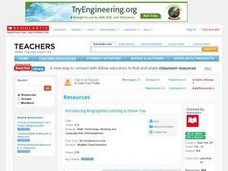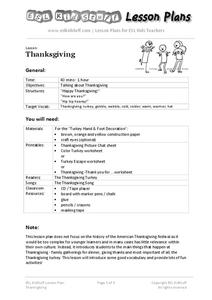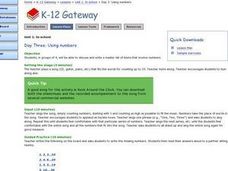Curated OER
Rep Tiles
Third graders use pattern blocks of one shape at a time to try to create a similar shape. They compare the perimeter of the new figure with the perimeter of the original shape and look for a pattern. Students use the pattern to predict...
Curated OER
Flower Power
Students explore the parts of flowers and how they reproduce. They dissect flowers and observe the reproductive organs. Students observe anthers and ovaries of Tiger Lilies under a microscope. They investigate how insects and other...
Curated OER
1950's Rock and Roll
Students complete an Individual Artist Information Sheet on famous 1950's Rock and Roll musician. They read one of the chapeters on "Elvis Pressley, Little Richard, Chuck Berry, Rockabilly, Jerry Lee Lewis, The Everly Brothers, or...
Curated OER
Create a Playbill!
Students examine the variety of elements for a written play and create a playbill. They read about and define literary elements on a worksheet, and participate in a dramatic reading. Each student then creates and publishes a playbill.
Curated OER
Introducing Biographies-Getting to Know You
Students study biographies as a nonfiction genre while examining a variety of examples. Next, they access and complete an online tutorial about biographies. They choose one person that interests them to conduct further research using a...
Curated OER
Exploring the World's Geography
Students discuss the seven continents of Earth and the diverse geography. After discussion, they create their own paper-mache globes which properly display all seven continents, the equator, and the prime meridian. They conduct research...
Curated OER
Impressionism and Beyond
Young scholars view a video, and they are reminded that Impressionism was an artistic movement that begin in Pairs in the 1800s. They are asked to think about the paintings featured in the video and describe the typical style of these...
Curated OER
Why is a salt marsh important?
Middle schoolers discuss the salt marsh. They define the following terms: habitat, water, land and air. Students work in small groups. They are asked why are they going to a salt marsh? Middle schoolers discuss whose habitat is it at...
Curated OER
Rhyme Time!
Students practice working with rhymes in groups to create wanted posters for rhyming words utilizing Publisher to assist them. They recognize words that rhyme and identify words that rhyme and show examples of rhyming words from the...
Curated OER
Rain Forest Adventures
Students identify and describe where tropical rain forests are located and examine the geographical correlation between rainfall and rain forest. They brainstorm what they think they know about tropical rain forests - where they're...
National First Ladies' Library
Rosie the Riveter
Learners identify and interpret the power of symbols. Then they research and identify what type of information that they can locate at the Library of Congress website and list what they learned from it in the time allotted. Students also...
Curated OER
Volcano Types
Students view a teacher created PowerPoint on the different types of volcanoes and complete a worksheet identifying the different types of volcanoes. They access the Internet to research a specific type of volcano. They create a...
Curated OER
The Primary Issue
Students analyze the 2008 presidential primaries by reading and discussing the New York Times Upfront article "Primary Matters." They complete a KWL chart, complete a handout, read the article and answer comprehension questions, and...
Curated OER
Warm Air versus Cold Air
Students discover that warm air takes up more space than cold air. In this science lesson plan, students perform 4 experiments using balloons to determine that the molecules of warm air are more spread out than those of cold air.
Curated OER
Mapping Exercise
In this mapping worksheet, students are given data of children exposed to health risks and their geographical location. Students plot each child's home and the risk factors using an (x, y) grid. They answer 2 questions about the...
Curated OER
Count On It!
Students investigate money. In this consumer math lesson, students use coins, identify their value, then group them in various ways to equal a dollar.
Curated OER
Post-Civil War American History
Fifth graders examine significant events in Post-Civil War America. In this Post-Civil War lesson, 5th graders investigate the important events after the war in 19th century America. They read primary source documents about six topics...
Curated OER
Community Helpers in our School and Town
Learners create a PowerPoint presentation. In this community helpers lesson, students discuss community helpers and create a t-chart to list what each community helper does. Learners watch a PowerPoint presentation, walk through the...
Curated OER
What's the Matter?
Learners explore matter. In this matter and technology instructional activity, students locate examples of solids, liquids, and gases inside and outside the classroom, and record their findings in a graphic organizer. Learners listen...
Curated OER
Multiplication Versus Addition
Second graders create arrays to study multiplication. In this multiplication lesson plan, 2nd graders split into teams to complete a multiplication table. One team uses addition to solve the table while the other uses multiplication....
Curated OER
Thanksgiving
Teach little learners about the first Thanksgiving. In this Thanksgiving lesson, young scholars discover what it was like to live during that time period. Students compare and contrast the first Thanksgiving to their own.
Curated OER
Gateway
Students practice listening to math problems in a foreign language. In this number sentence activity, students listen to the teacher ask them a question in a foreign language that has some type of number combination for an answer....
Curated OER
Times of Day
Students practice telling time using a foreign language. In this time telling lesson, students listen to a teacher tell them the time in their target language as they translate it while writing. Students utilize their new time telling...
Curated OER
My Friends: Day One: Likes and Dislikes
Students who are learning English as a second language examine likes and dislikes. In this likes and dislikes lesson plan, students examine the words that tell the things that a famous person might like or dislike. They work in groups to...

























